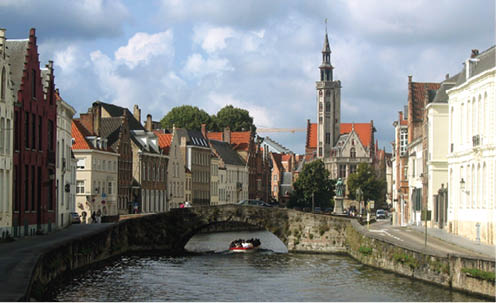Belgium

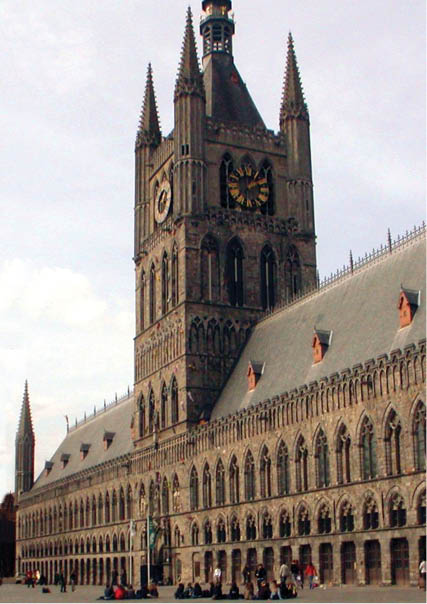
The medieval cloth workers hall in Ypres.
Considered the crossroads of Western Europe, Belgium is densely populated and crisscrossed with an extensive network of railroads and canals. The country’s central location has been both a blessing and a curse, for it was turned into a battlefield when invaded by Germany in both World Wars, and prior to that was the site of the Battle of Waterloo, which marked the end of the Napoleonic Wars.
Belgium was originally a Roman province of ancient Gaul, its people called Belgae. Conquered by the Franks in the 5th century, the region – known as Flanders – was part of the great Carolingian dynasty until the death of Charlemagne in 814, after which the region became a French fiefdom ruled by powerful counts.
Map of Belgium
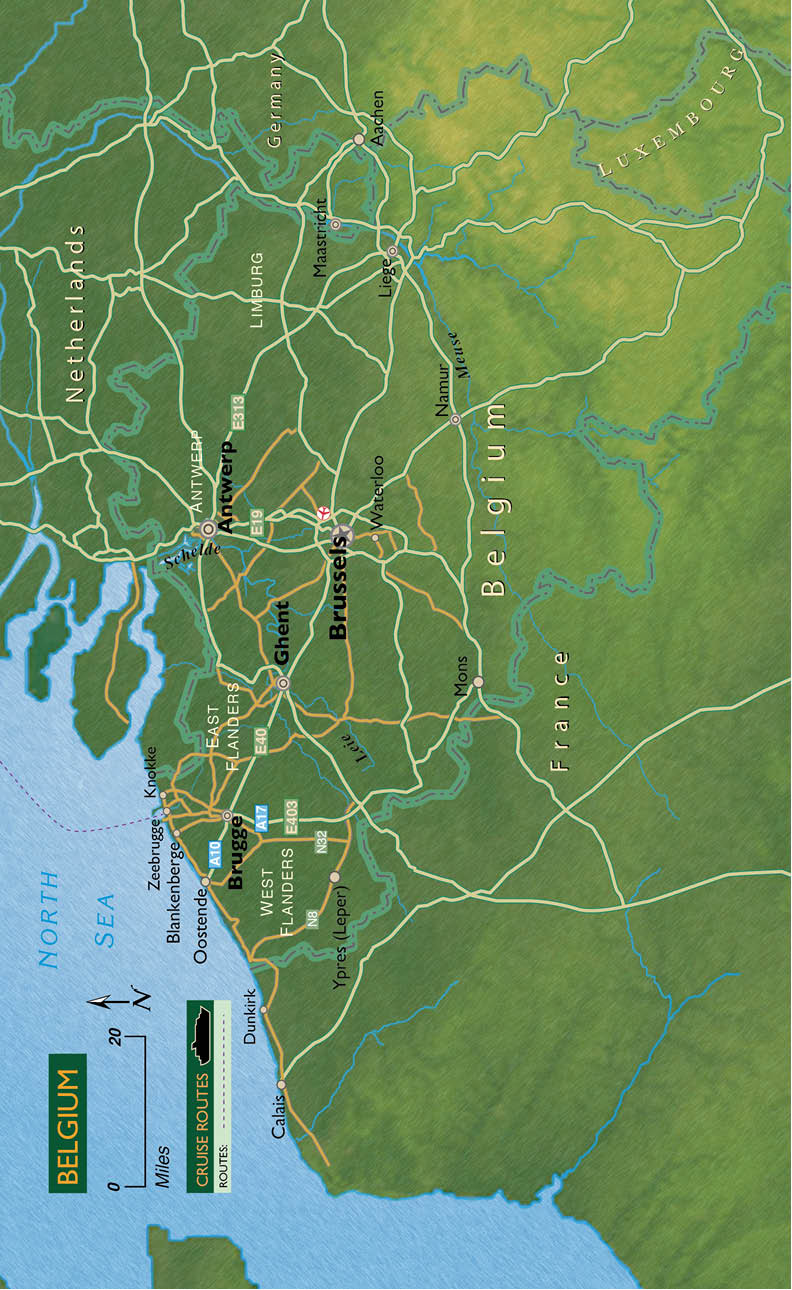
Their authority was eventually challenged by the merchant cities of Brugge, Ghent and Ypres, which prospered in the 13th century as producers of luxury textiles, their finished cloth – made exclusively of the finest English wool – finding a market all over Europe. Belgium’s traditional industries of lace making (in Brugge) and diamond cutting (in Antwerp) still thrive, and its beautifully preserved medieval towns are major draws for tourists.

A canal bridge near Market Square in Brugge.
Small in size, Belgium has a population of 11 million and consists of three partially autonomous regions – Flanders in the north, Wallonia in the south and Brussels, with a population exceeding one million, in the centre. Wallonia contains the country’s mining areas and heavy industries; Flanders is the location of the country’s textile, shipping and farming industries.
Famous for its fine chocolate, Belgium has also given the world the Brussel sprout, the Belgian horse (a large breed of draft horse) and the Belgian sheepdog.
The people of Flanders speak Flemish (the Belgian variant of Dutch) while Wallonians speak French. Brussels, the capital, is officially bilingual (French and Flemish). Regional tensions often dominate Belgium’s political scene.
The nation’s form of government is a parliamentary democracy under a constitutional monarchy dating to 1831, when Leopold I was installed as king after Belgium declared its independence from the United Kingdom of the Netherlands.
Officially neutral during both world wars, but defiant in the face of German occupation, Belgium has long been a proponent of European cooperation and unity, and its capital Brussels serves as the headquarters of the European Union.
Belgium’s unit of currency is the euro. The country calling code is +32. July 21 is National Day.
Old World artisanship still thrives in Belgium where popular shopping items for visitors include fine linens, Belgian tapestries (wall hangings, cushions, table mats) and delicate lacework items such as christening gowns and wedding veils. Famous for its gourmet chocolate, Belgium is where the praline – a chocolate shell (couverteur) filled with nougats or creams – was invented by a chocolatier in 1912.
Map of Zeebrugge

Cafés serve a wide variety of Belgian beers, and local cuisine features Flemish carbonnade (beef stewed in beer), frites (French fries), mussels in a white-wine sauce and Belgian waffles topped with whipped cream.

A student band performs in traditional Belgian attire.
Zeebrugge is the port of access for Belgium’s historic sites and cities. The cruise ships dock in the western outer port, at the Leopold II dam or the adjacent Albert II dock for smaller ships. Getting to Brugge by cab or by the ship’s shuttle can be pricey and the train is a good alternative. Zeebrugge-Dorp (village) and Zeebrugge-Strand (open only in summer) are the nearby train stations – both about 1-1/4 miles (2 km) from the pier but along a busy industrial port area, so walking this stretch is not pleasant. There is usually a shuttle bus available at quay-side to the nearby town of Blankenberge where rail service to Brugge is more frequent. Efficient train service (www.b-rail.be) connects from Blankenberge with all parts of Belgium. Travelling between Brugge, Ghent and Antwerp on local trains takes between half an hour to an hour. Distances to various cities from Zeebrugge: Brugge (9 miles/15 km); Ghent (31 miles/50 km); Antwerp or Brussels (63 miles/100 km). Most railway stations rent bicycles, which is a popular way for locals to get around (bike lanes are marked in red). However, walking is a good way to sightsee in Brugge and Ghent, where the attractions are concentrated in a compact area of narrow streets. Canal boat tours provide excellent overviews in both cities.

Market Square in Brugge.
Founded in the 9th century on an inlet of the North Sea, Brugge (spelled Bruges in French) became a major port of the Hanseatic League and a bustling centre of trade, commerce and wool processing. Powerful and prosperous, Brugge was also the cradle of Flemish art in the 14th and 15th centuries, its churches and museums housing works by Jan van Eyck and Gerard David. Brugge lost its lucrative maritime trade to Antwerp after its harbour filled with silt, but it remained a centre of commerce and humanism. Erasmus called Brugge “the new Athens” and Sir Thomas More wrote Utopia while in Brugge on a trade mission in 1515.
Today, Brugge is an UNESCO World Heritage Site and considered one of the best-preserved medieval cities in Europe. Many of its brick Gothic buildings were restored in the 19th century when a colony of English aristocrats took an interest in the city’s artistic heritage.

A painting of Brugge given to a Canadian soldier in 1944 by a grateful resident who had been hiding from the Gestapo.
Much of Brugge would likely have been destroyed by retreating German forces during World War II if not for the actions of the 4th Canadian Armoured Division, whose soldiers surrounded the city in September 1944. The commanding officer of the 22nd Manitoba Dragoons, who entered Brugge to meet with the German commanding officer, agreed to let the German soldiers evacuate unharmed if first they disarmed all the explosives they had wired to the bridges and buildings. A pair of bronze bison statues flanking one end of Canada Bridge were installed to commemorate the liberation of Brugge.
Map of Brugge

1. Market Hall – Brugge’s notable buildings include the 13th-century Market Hall with its famous belfry, which featured prominently in the movie In Bruges. Its narrow steep staircase of 366 steps (accessible by entry fee) leads to an observation deck at the top.
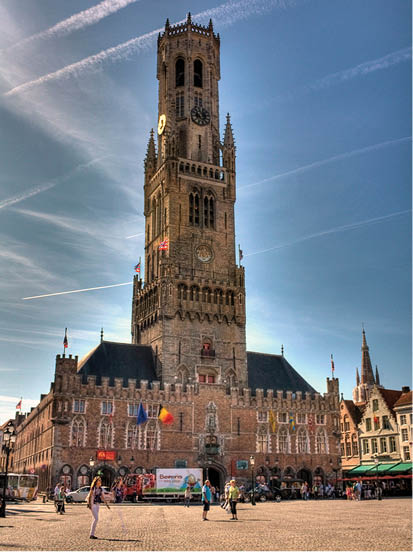
Market Hall’s famous bellfry.
2. City Hall – This 14th century building is located in nearby Burg Square.
3. Chapel of the Precious (Holy) Blood – begun in the 12th century and located near the City Hall.
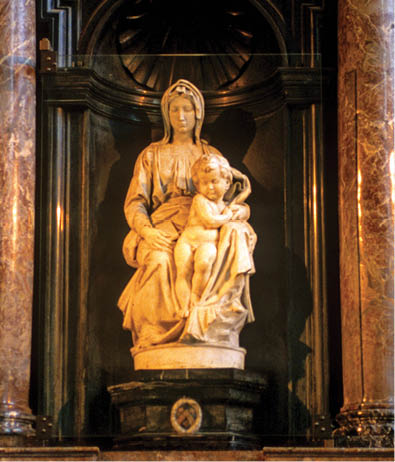
Michelangelo’s Madonna in Church of Our Lady.
4. The Church of Notre Dame – begun in the 13th century, this church contains the tombs of Charles the Bold (ruler of the Low Countries) and his daughter Mary of Burgundy. Its brick spire is one of the tallest of its kind and the church’s altarpiece enshrines a marble sculpture by Michelangelo called Madonna of Bruges, which was acquired by a local family of wealthy cloth merchants and donated to the church. Twice this treasure was looted, first by French revolutionaries in the 1790s and again by Nazi Germans in 1944, and has been protected by bullet-proof glass since 1972.
5. Gruuthuse Museum – Located behind the church, this museum is a former palace now housing a collection of 16th- and 17th-century tapestries.
6. Groeninge Museum – Locaed nearby the Gruuthouse Museum, this museumhouses paintings by Flemish masters.

Ghent’s canalside architecture.
Founded by a French missionary in 630 AD at the confluence of the Leie and Scheldt rivers, Ghent is packed with churches, museums and sidewalk cafés. Canal boats take visitors past many of the small city’s medieval monuments, including the 12th-century Gravensteen fortress (known as the Castle of the Counts), which stands in a bend of the river with a view over the old town. Groot Leeshuis was the city’s meat house during the Middle Ages and this cavernous building now houses a food market selling Belgian specialties.
St. Michielsbrug (St. Michael’s Bridge) provides the best vantage for viewing the towers of St. Niklaaskerk (St. Nicholas church), Belfort and St. Baafskathedraal, which contains Van Eyck’s altar painting Adoration of the Mystic Lamb. Shops and cafés are found in the harbour area, including Patershol (north of the Gravensteen), which is one of the oldest parts of the city. Attractions lying south of the historic core include Vooruit (a monumental concert hall built in 1912) and S.M.A.K. (a contemporary art museum).
The town of Ypres (called Ieper in Flemish) rivalled medieval Brugge and Ghent as the centre of Flanders’ flourishing cloth industry. Today it’s remembered as the scene of three great battles fought during World War I as German forces attempted to advance toward the Channel ports of Dunkirk and Calais. The famous poem ‘In Flanders Fields’ commemorates the thousands of British and Canadian soldiers killed at Ypres, and it was written by Lieutenant Colonel John McCrae, a physician serving with the Canadian Expeditionary Force at Ypres. The town was completely destroyed during the war and later rebuilt, its restored buildings including a 13th-century cloth workers hall and the Gothic Cathedral of St. Martin. Outside the town walls there lie some forty military cemeteries, where “poppies blow, between the crosses, row on row.”
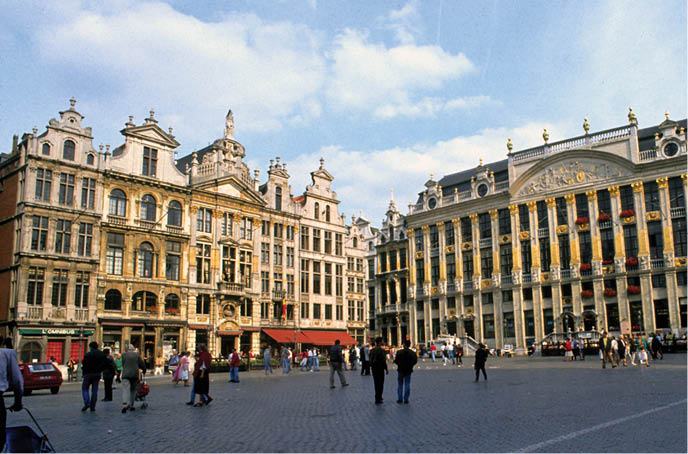
Grand Palace in Brussels.
The capital of Belgium and the European Union, Brussels was a medieval commercial centre on the trade route from Brugge and Ghent to the Rhineland. It became the seat of the dukes of Burgundy in 1430 and a city of art and culture. Grand Place is the city’s beautiful central square of medieval buildings and outdoor cafés. This massive square, described as “a rich theatre” by Victor Hugo, is surrounded by Gothic buildings such as the 13th-century Maison du Roi or Broodhuis (meeting place of the old States-General of the Netherlands), the 15th-century City Hall, and a number of rebuilt Gothic guildhalls. Nearby is the famous Mannekin-Pis, a statue sculpted in 1619 of a small boy urinating. Another famous landmark in Brussels is the Atomium, a gigantic model of an iron molecule built for the 1958 World Fair in Brussels. The Waterloo battlefield is 10 miles south of the city.
Antwerp, the gem-trading capital of the world, is located 60 miles (97 km) up the Scheldt River from the North Sea. The cruise terminal is located in the heart of the city where the river quays – constructed in the 19th century to prevent flooding – have been reinvented in the 21st century to reconnect the historic waterfront with the cobble streets of the old town.
The great Flemish painters Rubens and Van Dyck resided in Antwerp and their works adorn the city’s churches and museums. Splendid buildings include the Gothic Cathedral of Notre Dame overlooking Groenplaats (Green Square), the churches of St. Paul and St. James (the latter containing the tomb of Rubens), and Rubens’s house, which is now a museum. The Renaissance-style city hall stands in the central square, called Grote Markt (Market Place), which is lined with guild halls.
The modern Museum ann de Stroom (Museum on the Stream) focuses on Antwerp’s history, and the new Red Star Line Museum tells the story of the two million emigrants who embarked here on their voyages to America and a new life.
